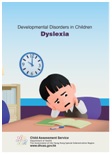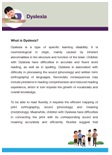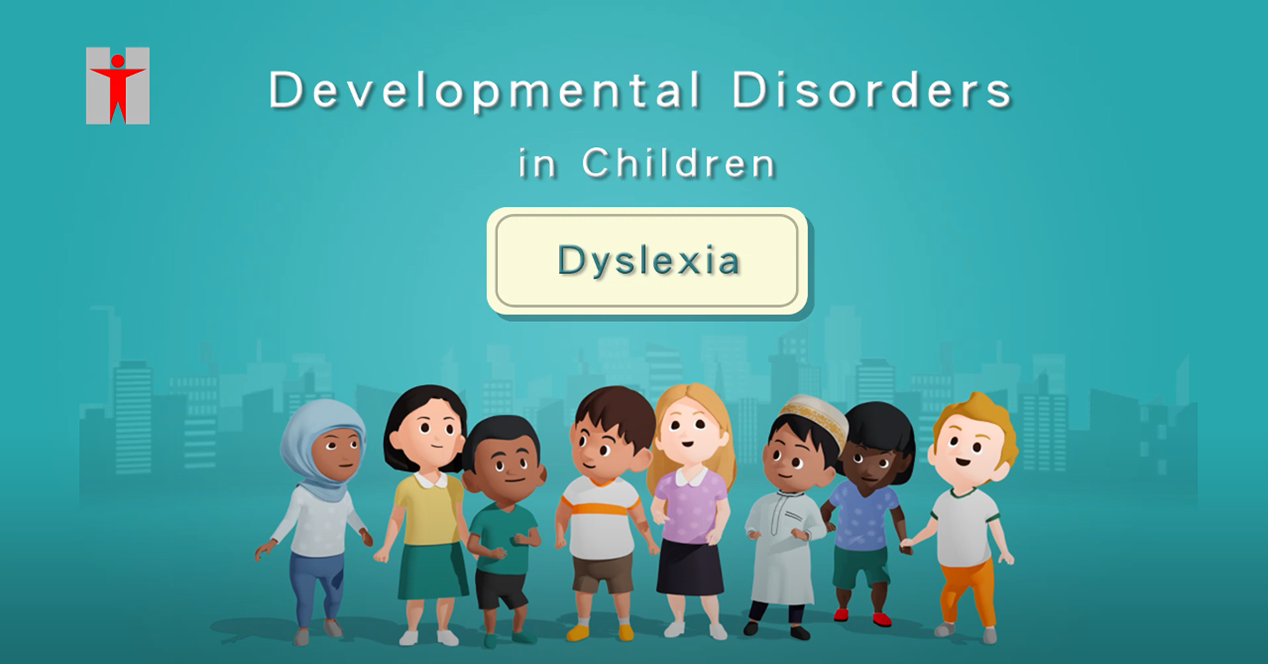Dyslexia
Dyslexia is a type of specific learning disability. It is neurobiological in origin, mainly caused by inherent abnormalities in the structure and function of the brain. Children with Dyslexia have difficulties in accurate and fluent word reading, as well as in spelling. Dyslexia is associated with difficulty in processing the sound (phonology) and written form (orthography) of languages. Secondary consequences may include problems in reading comprehension and reduced reading experience, which in turn impede the growth of vocabulary and overall knowledge.
To be able to read fluently, it requires the efficient mapping of print (orthography), sound (phonology) and meaning (morphology). Meanwhile, children with Dyslexia have difficulties in connecting the print with its corresponding sound and meaning accurately and efficiently. Studies suggest that insufficient phonological awareness and an impaired ability to establish mappings between a written language and a spoken language are the key factors contributing to Dyslexia in English word learning. In Chinese word learning, apart from phonological sensitivity, morphological awareness, as well as orthographic skills are also important cognitive-linguistic skills.
It is important to note that factors such as intellectual disability, sensory impairments, or a lack of educational opportunities cannot fully account for the learning disabilities in children with Dyslexia.
Clinical features and the impact of Dyslexia evolve alongside with the children’s age::
Preschool:
Preschoolers with Dyslexia may experience slower language development or articulation problems compared to children of the same age. They may find it excessively difficult, or may take much longer time, to learn how to read letters, simple words, and numbers.
Early primary school:
In this early phase of schooling, students with Dyslexia have difficulties in learning the association between sounds and symbols of the Chinese characters or English words, as well as in parsing or blending sounds of letters when reading out or spelling words in English. Moreover, the child may confuse words and characters that sound or look alike. Errors such as reversing the order and direction of strokes and confusing between radical components, also appear when writing Chinese. For English writing, children may be confused with the sequence of letter clusters. They may perform poorer in phonetics and have difficulty pronouncing multiple syllable words.
Senior primary school:
Students show increasing difficulties in reading and writing. They may also have problems with reading comprehension and written expression. These will ultimately result in general academic underperformance.
Secondary school:
Secondary school curriculum places greater emphasis on complex organizational skills and has higher demand on executive functioning, which often are the weaknesses of students with Dyslexia. Furthermore, difficulties in reading comprehension, note-taking, and written expression negatively impact their learning experience. Social and psychological problems may arise because of low self-esteem and poor peer relationship. All these factors may lead to academic underperformance and cast adverse effects on social-emotional development.
Dyslexia occurs in people of all backgrounds. Reported figures from different countries show that as many as one in ten school-aged children has Dyslexia. In Hong Kong, the prevalence of children with Dyslexia was reported to be 9.7 to 12.6%. Around 70% of the cases were classified as mild in severity, 20% as moderate, while the remaining 10% as severe.
The cause of Dyslexia is complex and multifactorial. Dyslexia is associated with observable differences in brain structure and functions. Neuroimaging studies show that brain networks, specifically those in the left hemisphere which is responsible for speech, language, and reading skills, may be different in structure, function or connectivity in individuals with Dyslexia. Meanwhile, genetic studies demonstrate the role of genetic influences on Dyslexia. Clinical studies show that siblings and parents of an individual with Dyslexia have higher chances of also having reading problems.
Children with multiple cognitive-linguistic deficits are at higher risk for Dyslexia, including phonological awareness, rapid serial naming, verbal short-term memory, vocabulary, general oral language skills, and graphomotor processing speed. Meanwhile, it has been put forth that language skills are the critical foundation for developing representations between print and sounds.
There is growing research evidence on a risk-resilience framework which entails that the risk of developing Dyslexia is based on a cumulative risk and protection model, and is probabilistic rather than deterministic. Cognitive-linguistic deficits and environmental risk factors can interact with each other to increase or decrease the likelihood and severity of reading problems.
Symptoms arising from other developmental or psychosocial problems, including intellectual disability, developmental language disorder, attention deficit/ hyperactivity disorder, or academic underachievement due to inadequate learning experience, can be confused with those of Dyslexia.
Children with Dyslexia often have other comorbid developmental problems, such as other specific learning disabilities, attention-deficit/hyperactivity disorder, developmental language disorder, speech sound disorder, and developmental coordination disorder.
The mainstay of managing Dyslexia lies in reading remediation that are theoretically-sound and evidence-based, teaching approaches that are specifically tailored to the student’s learning style and needs, and appropriate accommodations to be provided in the learning environment.
Remediation of reading difficulties in English begins with the teaching of letter-sound correspondence in order to achieve effective reading and spelling skills. The teaching approach should be systematic, cumulative and multi-sensory. Other measures, such as individualized educational programme, learning- or assessment-related accommodations and assistance can also improve one’s reading and writing performance.
In Chinese reading, phonological sensitivity, morphological awareness, visual-orthographic processing, and fluency are the four essential cognitive-linguistic skills; targeting one or more of these skills in training could promote better word reading in children. About 80-90% of Chinese characters are compounds of semantic radicals and phonetic radicals; the semantic radicals represent the meaning of characters, while the phonetical radicals indicate the sound. As Chinese characters are morphosyllabic (i.e. each word is consisted of one meaning and one syllable sound), teaching explicit word attack strategies by segregating the phonetic (sound) and semantic (meaning) components of the character helps in decoding the sound and meaning of a word character. However, the mapping between sound and script are relatively opaque in Chinese, it is therefore also important to help children effectively process visual-orthographic information, i.e. to understand the internal structures and meaningful components of the characters, as well as the related implicit rules. Strengthening morphological awareness helps in understanding Chinese vocabularies, which are formed by the combination of two or more individual characters.
Meanwhile, individualized educational plans, accommodations in examinations, assistive technology are also necessary to enable effective learning at school.
There is no documented medical treatment for Dyslexia at the moment. Alternative therapies for Dyslexia are sometimes offered, but many of them have been shown to have uncertain theoretical bases and limited replicable scientific evidence.
These include nutritional supplement, optometric vision therapy and lenses, auditory integration training, programmes utilizing sensori-motor integration or vestibular-cerebellar related strategies, and psychotherapy. As some children with Dyslexia also have other coexisting conditions as mentioned above, these alternative approaches may help them with the other developmental problems rather than Dyslexia per se.
Although the biological characteristics associated with Dyslexia do persist in affected individuals, different measures can be used to ameliorate or overcome the difficulties faced by these individuals as they grow up.
In the cumulative risk and resilience model of Dyslexia, it is evident that there are protective and promotive factors that influence reading outcomes. In addition to receiving explicit instructions on word attack strategies, having better language skills, having a growth mindset that attributes success to persistent learning, practice, and effort, as well as having adaptive coping skills, such as being proactive, setting goals, and regulating emotions are keys to reducing the negative consequences of Dyslexia. Meanwhile, support from parents, teachers, and peers could help reduce the feelings of loneliness and social isolation associated with Dyslexia, thereby improving the children’s self-esteem and overall sense of wellbeing.
In conclusion, the severity of Dyslexia, level of cognitive ability, effectiveness of educational and psychological support, as well as management of any associated co-morbid problems can affect the long-term prognosis in these children.
-
British Dyslexia Association
http://www.bdaDyslexia.org.uk/ -
Early Literacy for Chinese Children
http://literacyresearch.wixsite.com/chinese -
Hong Kong Association for Specific Learning Disabilities
http://www.asld.org.hk -
Hong Kong SLD Research Team
http://www.psychology.hku.hk/hksld/ -
International Dyslexia Association
https://Dyslexiaida.org/ -
LD Online
http://www.ldonline.org/ -
Special Education Service, Education Bureau, Hong Kong
http://www.edb.gov.hk/en/edu-system/special/policy-and-initiatives/special-edu-serv/index.html -
Education Bureau : Special Education Information Online
http://sense.edb.gov.hk/en/index.html
- Catts, H. W., & Petscher, Y. (2021). A Cumulative Risk and Resilience Model of Dyslexia. Journal of Learning Disabilities. https://doi.org/10.1177/00222194211037062
- Chung, K. K., Ho, C. S., Chan, D. W., Tsang S. M., & Lee, S. H. (2009). Cognitive profiles of Chinese adolescents with Dyslexia. Dyslexia, 392, 2-23.
- Chung, K. K. H., Ho., C. S. H., Chan, D. W., Tsang, S. M., & Lee, S. H. (2011). Cognitive skills and literacy performance of Chinese adolescents with and without Dyslexia. Reading and Writing, 24, 835-859.
- Cramer, S. C. & Ellis, W. (1996). Learning disabilities: Lifelong issues. Baltimore: Paul H. Brookes Publishing Company.
- Ho, C. S. H., Chan, D. W., Chung, K. K. H., Lee, S. H., & Tsang, S. M. (2007). In search of subtypes of Chinese developmental Dyslexia. Journal of Experimental Child Psychology, 97, 61-83.
- Hulme, C. (2020, September 21). Commentary: The critical role of oral language deficits in reading disorders: reflections on Snowling and Hulme (2021). Association for Child and Adolescent Mental Health. https://acamh.onlinelibrary.wiley.com/doi/10.1111/jcpp.13324.
- McBride-Chang, C., Lam, F., Lam, C., Chan, B., Fong, C. Y.-C., Wong, T. T.-Y., & Wong, S. W.-L. (2011). Early predictors of Dyslexia in Chinese children: Familial history of Dyslexia, language delay, and cognitive profiles. Journal of Child Psychology and Psychiatry, 52, 204-211.
- McBride, C., Wang, Y., & Cheang, L. M. L. (2018). Dyslexia in Chinese. Current Developmental Disorders Reports, 5(4), 217–225. https://doi.org/10.1007/s40474-018-0149-y
- Peterson, R. L. & Pennington B. F. (2015). Developmental Dyslexia. Annual Review of Clinical Psychology, 11, 283-307.
- Shaywitz, S. & Shaywitz, J. (2020). Overcoming Dyslexia: Completely Revised and Updated. New York: Random House.
- Snowling, M. J., & Hulme, C. (2020, September 21). Annual research review: Reading disorders revisited – the critical importance of oral language. Journal of Child Psychology and Psychiatry, 62(5), 635–653. https://doi.org/10.1111/jcpp.13324

Short Factsheet

Long Factsheet
